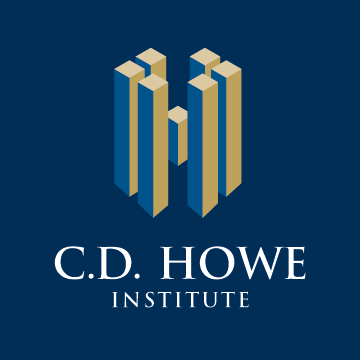Home / Publications / Research / Canadian Economy Contracts, But Does Not Meet Recession Definition
- Research
- |
Canadian Economy Contracts, But Does Not Meet Recession Definition
Summary:
| Citation | . 2025. "Canadian Economy Contracts, But Does Not Meet Recession Definition." ###. Toronto: C.D. Howe Institute. |
| Page Title: | Canadian Economy Contracts, But Does Not Meet Recession Definition – C.D. Howe Institute |
| Article Title: | Canadian Economy Contracts, But Does Not Meet Recession Definition |
| URL: | https://cdhowe.org/publication/canadian-economy-contracts-but-does-not-meet-recession-definition/ |
| Published Date: | September 22, 2025 |
| Accessed Date: | September 23, 2025 |
Canada’s real gross domestic product (GDP) declined by 0.4 percent in the second quarter of 2025, driven by a 7.5 percent drop in exports and a 9.4 percent drop in investment in machinery and equipment. The decline was steeper than had been forecast, prompting the Bank of Canada to cut its policy rate. The drop in economic growth has also stirred fears of a possible recession. Council members evaluated whether the evidence suggests we are in a recession, and determined conditions have not yet been met to make this call. The Council stands ready to meet if conditions deteriorate.
The C.D. Howe Institute’s Business Cycle Council (BCC) is an authoritative arbiter of business cycle dates in Canada. Under its methodology1C.D. Howe Institute Business Cycle Council. 2017. “Business Cycle Council Methodology.” Council Report. Toronto: C.D. Howe Institute. December 20. https://cdhowe.org/publication/business-cycle-council-methodology/., outlined in December 2017 and updated in December 2019,2C.D. Howe Institute Business Cycle Council. 2019. “Business Cycle Council Communiqué – December 2019.” Council Report. Toronto: C.D. Howe Institute. December 17. https://cdhowe.org/publication/business-cycle-council-communique-december-2019-2/. a recession is defined as a pronounced, persistent, and pervasive decline in real economic activity. The Council does not apply hard-and-fast rules on these dimensions, instead relying on several guidelines in making our recession determinations.
In assessing whether a recession is underway, the Council examines multiple variables. First, a decline in GDP lasting at least one quarter is a necessary minimum for a recession. If an economic slowdown does not result in at least one quarter of outright contraction, it cannot be said to display the sequential reductions characteristic of business cycle downturns. Second, the decline in economic activity must either be large or be accompanied by weakness in contiguous quarters, implying a net contraction, or at least stagnation, over a two-quarter period. Third, the decline must be broad in nature – that is, experienced by more than just a small number of industries.
Members noted that second-quarter GDP was the first quarter of negative growth in 2025, and the fall in economic activity satisfied the first recessionary criterion. The C.D. Howe Institute’s diffusion index3C.D. Howe Institute. 2025. “Toolkit of Economic Indicators.” September 11. https://cdhowe.org/publication/toolkit-economic-indicators/. has been below the critical 50 threshold in two of the last three months to June, which members suggested might imply the third criterion is also met. Tempering that argument, however, is the fact that the three-month average, which strips away month-to-month volatility, stood at exactly 50 in June and has been consistently at or above 50 throughout 2025, with the exception of April, when it was 49.
Members agreed that the second criterion is where the recession argument currently falls short. While significant, a drop of 0.4 percent in GDP is not large enough over a single quarter for the Council to call a recession. To put this in perspective, even if this rate of decline were to continue over the next three quarters, it would be only the second-mildest recession in the last sixty years. At present, with the data we have, GDP grew by 0.4 percent in the first quarter of 2025, and the cumulative growth rate in the first two quarters of the year was slightly positive at about 0.1 percent. Moreover, Statistics Canada’s advance estimate for real GDP by industry in July 2025 is for a 0.1 percent increase.
On aggregate, the Council judges that the Canadian economy does not presently meet the definition of a recession according to the latest available data.
However, the Council is monitoring developments closely and will meet to discuss a recession call if GDP contracts again in the third quarter. Members highlighted that stagnating and weak labour market data were a particular concern. Payroll employment decreased by 0.2 percent in June, with business cycle-sensitive private-sector employment even more negative. The Labour Force Survey released on September 5 reported that total employment declined by 66,000 (or 0.3 percent) in August, with the unemployment rate rising by 0.2 percentage points to 7.1 percent – the highest since August 2021. This would put in doubt any positive momentum from the advanced GDP estimate of growth in July.
The next Statistics Canada report on quarterly GDP by expenditure (for Q3 2025) will be released on November 28.
Members of the C.D. Howe Institute Business Cycle Council
Members of the Council participate in their personal capacities, and the views collectively expressed do not represent those of any individual, institution, or client.
Co-Chairs:
- Jeremy Kronick, Vice-President, Economic Analysis and Strategy, C.D. Howe Institute
- Steve Ambler, Fellow-In-Residence, David Dodge Chair in Monetary Policy, C.D. Howe Institute
Members:
- Edward A. Carmichael, Founding Partner, Ted Carmichael Global Macro
- Philip Cross, Former Chief Economic Analyst, Statistics Canada
- Stephen Gordon, Professor of Economics, Université Laval
- Eric Lascelles, Chief Economist, RBC Global Asset Management
- Stéfane Marion, VP & Chief Economist, National Bank of Canada
- Angelo Melino, Professor of Economics, University of Toronto
